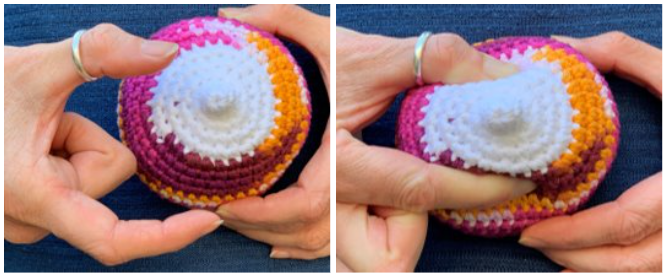For four years a previous client (let’s call her 'Anna') has taken the opportunity to make a comment to warn others not to use my services, each time I am recommended locally on Facebook.
For years I have looked the other way. Told myself not to dwell on it. Not to focus on one negative comment (well several, but from one person) amongst the many good.
I only know it has been four years because yesterday, as I followed a link to see that I had been kindly recommended again, up pops Anna’s comment AGAIN (‘I wouldn’t recommend Dee’). I look up Anna’s name in my client records, to gain some kind of insight into why she feels this way, and I see that I saw her in 2019!
I recognise the unremarkable information that has been recorded and realise that I have looked up these records before (each time I have read the words ‘I wouldn’t recommend Dee’). Evidently, I have looked her up in the same knee-jerk, heart-wrenching response (why is she saying this?). And each time I have seen her notes, satisfied myself that there is nothing of note and decided to let it go.
But this time I realise she is never going to stop. Something happened to her that makes her want to prevent 10’s, possibly 100’s of women who are struggling with feeding to consult me. Suffice to say, I don’t know why.
I see hundreds of families a year and as I read her notes I realise the only reason I recognise her name is the frequency of which I have seen her comments on Facebook ( ‘I wouldn’t recommend Dee’).
The notes tell me that her baby underwent a tongue-tie division at an NHS clinic 6 days previous to our breastfeeding consultation. The baby is reported by Anna to have ‘fed better’ for the first day after the division, but is now feeding for 40 mins (plus) on each side’.
Anna feeds the baby on one side in the middle of night and expresses the other. ‘Top-ups’ are given at the end of the evening, then the baby sleeps for 3 hours. Anna has ‘started taking fenugreek, which appears to have helped’.
I confirm the 5 week old baby’s tongue, whilst still ‘heart shaped’ (as the tongue had grown in utero with a restricted frenulum), is currently moving freely.
The baby looks underweight, and has not been weighed since day 10, therefore, I advise to get this checked as soon as possible. As he is underweight and Anna feels her supply is low, I advise a feeding plan designed to increase the baby’s milk intake, whilst also protecting breast milk supply. Anna states that she does not feel she can conform to this, but she wants to fully breastfeed.
We go over positioning and attachment in order to optimise it for effective feeding and we discuss the feeding plan. The feeding plan involves keeping the baby actively feeding, switch nursing, and then if the baby requires more milk (to sustain optimal growth and development) a prescribed amount of expressed breast milk, or formula, will be required.

In order to provide expressed breast milk, expressing will be necessary. If formula is still needed and the wish is to breastfeed, then efficient and frequent breastmilk removal is essential.
This plan is a shocker!
I get it.
Who has time for all that whilst looking after a newborn baby, let alone the other requirements of a family? But it is not my plan. It is an explanation of physiology.
The physiology of breast milk production requires efficient and frequent removal of milk from the breasts to ‘demand’ and produce the quantity of milk to sustain a baby.
But what else can be done?
We need to also consider the baby.
What should/could be done to the baby to make it feed more efficiently and for this ‘shocker’ of a feeding plan not to be required?
For some, a change to positioning by the mother can aid a more effective latch, et voila!
For many, a poor latch and therefore poor milk removal has been going on for some weeks and supply has already been affected.
If (and this is a big ‘if’) mum has sought help early, it may be possible for her to increase supply (and consequently weight gain), by feeding more frequently (perhaps 10-12 times in 24 hours).
Improve positioning, improve latch, and perhaps also employ strategies such as switch nursing with compressions, and all will be well.
For a few, just feeding 8-10 times in 24 hours instead of 6-7 will do the trick on its own!
But what else?
What else can be done to ‘fix’ the baby?
What if the baby’s tongue is restricted by a short or tight lingual frenulum?
Well, then we can divide the frenulum, using single-use surgical scissors (or laser, depending on the provider, but the majority of us in the UK use surgical scissors).
If a tongue function assessment doesn’t warrant performing this procedure, then no ethical tongue-tie practitioner is going to recommend it. However, if there is some ambiguity around the findings of a tongue function assessment and the parent has addressed all of the above, including this ‘shocker’ of a feeding plan, plus ‘body work’ if indicated, AND the parents wish to see if a division of the baby’s frenulum will improve feeding, then the tongue-tie practitioner may then consider it to be a reasonable option. It is worthy of note here, that in my experience in these circumstances, it doesn’t usually solve the problem.
So now let’s get back to Anna.
What happened during her consultation? We discussed her feeding history, thus far. The baby had been born with a very restrictive frenulum, and this had already been released (less than a week ago), so I can’t help there. It is clear that for whatever reason the baby is not receiving enough milk. Therefore I have to advise that the baby needs to receive more milk. Being a Lactation Consultant I provide options on all the ways this may be possible.

Following the visit my records show that Anna was sent some ‘follow-up’ materials comprising of:
- Attachment guide to support our consultation
- Laid Back, Cross Cradle & Rugby Hold Positioning guide (as covered in our breastfeeding consult)
- Breast Compressions
- Tongue-tie Aftercare
- Step-by-step feeding plan, with additional resource links
And the invitation to contact me for further support is extended. I am satisfied that I provided high quality support.
Anna's experience?
Well I can only make assumptions. So I have reached out to her to tell her story, but so far she has chosen not to respond.




